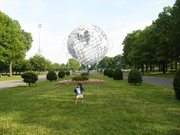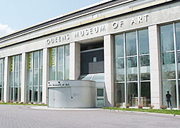Queens is no Manhattan. It's no Brooklyn, either. Rather than accumulating juicy tourist attractions and historic landmarks where something greater than you happened long before you got there, Queens is a residential area focused on making it easy on those live in it. It is, in a way, New York City's living room.
Does that mean you'd be better off skipping it in your travel? It depends. If you want a complete New York experience, it would be insane to miss it. If you just want the touristy highlights, Queens will have little to give you.
If you belong to the former kind of person, here is a guide for you.

By the 1960s, New York was on the way to replacing Paris as the city most associated with World Fairs. The World Fair of 1939 had introduced exotic inventions such as color television, photography, nylon and air conditioning to the human race. Which helped putting New York in the map. In every map, actually. But more crucially, it put its location on the map -- a newly constructed park called the Flushing Meadows in a residential borough called Queens. The fair was such a success that, 20 years later, a lot of businessmen wanted to recreate it purely based on nostalgia.
Perhaps moved by that feeling of nostalgia, or perhaps because it was really practical, they decided to locate this new fair in the Flushing Meadows Park again. It eventually took place in 1964 and those who attended it became some of the first humans ever to interact with a computer thanks to IBM's exhibit. That was quite possibly its only memorable achievement. The Fair was not a success and it would be the last one ever to be hosted in New York. Only one thing was left improved by it -- Flushing Meadows Park. It was graced with a spectacular, 12-story high, stainless steel representation of Earth encircled by the orbits of the first satellites. It is called the Unisphere and it has become of Queen's most immediate and distinct symbols.

The Unisphere is so spectacular that it would justify the trip to Flushing Meadows Park alone. But it also has one important thing to it -- it's proximity to the Queens Museum of Art and its literally unique vision of New York City.
It is ironic that you have to go to Queens to get a new perspective of Manhattan. But the only alternative to seeing New York City in its totality like this -- every one of its 895,000 structures at the same time -- is to be Superman and to fly thousands of feet above the ground and then using his super-vision to see through the clouds. Not all tourists seem able to do this.
The Panorama of the City of New York is a fastidious recreation of every single building erected in the City's 320 square miles into a "small", 9,335 square foot model. Which means that an inch equals 100 feet. This really boggles the mind after being awed by the mere size of New York City's buildings -- as it happens, the the 1,500-foot-tall Empire State Building is 15 inches. Far Rockaway is a jump shot from Central Park. The otherwise enormous Bronx Zoo here measures 1,500 square inches.
The story behind this impressive achievement is distinguishably uneventful -- the powers behind the 1964 World Fair wanted to show off the city's ultra-modern infrastructure (we may have Abu Dhabi and Tokyo nowadays, but back then there was literally nothing like it) and so they commissioned something that was impossible to realize -- a model of the entire city of New York with only a one percent margin of error allowed. Obviously, the sane thing would have been to politely say no, but for some reason model makers Lester Associates agreed to it. For three years they designed and constructed thousands and thousands of miniature buildings until it was completed. Its success was phenomenal. It received about 1,400 visitors each day and, next to the Unisphere, was the most memorable thing to come out of the 1964 World's Fair.

After the Fair, however, things got complicated. The city experimented a real estate boom in the 1970s and the 1980s (which would tragically result in the Wall Street crash of the late 1980s), so thousands of buildings had to be updated year after year if the donations so allowed. It turned out people were more eager to invest in real buildings that in plastic and wooden miniatures, so for years the Panorama existed in a limbo, somewhere between 1964 and, say, 1984. It was a waste of potential for a masterpiece that, with the surge of computer graphics, would never be built again. This partially explains why the museum invested $15 million on a renovation -- the original team used the same plans as they had used for the original model and then superimposed satellite pictures. Today, the Panorama is a vivid, more or less up-to-date representation of New York as you have seen it in real life.
It's a fantastic idea to leave this for the final day of your trip. You will see the city you have traveled to (and through) for days and it will summarize your New York experience. And then, you can say goodbye to it.